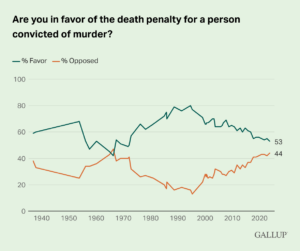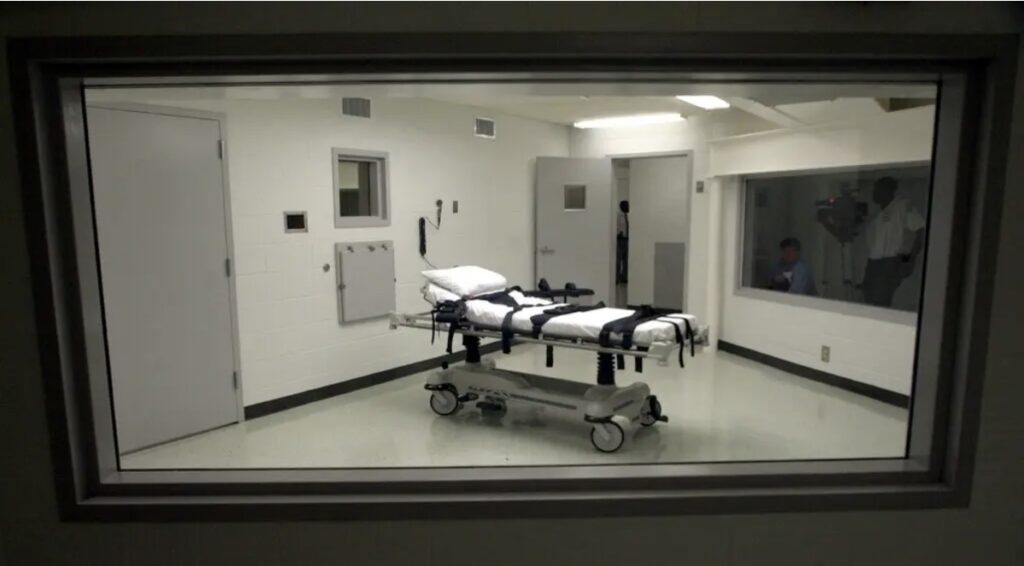In Alabama’s courtrooms, life and death hang in the balance. Capital punishment, one of Alabama’s controversial elements in its justice system, casts a dark shadow on the moral compass of society. From the gavel strike to the pleas for mercy, the story of death penalty in Alabama presents a moral imperative. Every verdict carries profound implications and every voice echoes with a cry for human dignity.
Walking down the hallway, flanked by two prison guards, closer with every step to the chamber where the execution will take place, after the chamber is fully sealed.1 The individual is escorted into the chamber. Once inside, nitrogen gas is released, gradually displacing the oxygen and creating an airtight atmosphere devoid of oxygen. The method is simple and effective as gas displaces oxygen, leading to a state of hypoxia. Although simple and effective, oxygen deprivation causes a series of physiological responses in the body, such as dizziness, confusion, loss of consciousness, and ultimately death. Reportedly, individuals lose consciousness within seconds, relatively quickly and supposedly painlessly. The two ways to administer a nitrogen gas executions are within an air tight chamber or with a special type of gas mask. Depending on the prison, either a mask is used, then it must have an airtight seal so that the inmate cannot breathe any oxygen that would prolong the suffering until death and prevents exposure to a deadly level of gas for the execution team or present witnesses. Death row inmates experience this fate in Oklahoma, Alabama, and Mississippi. How did this practice become so popular?

Capital punishment was characterized as a method to appease public scrutiny. A sense of social balance was founded with the idea of capital punishment that the most heinous crimes deserved the most justice serving consequence- an eye for an eye to appease social unrest. The United States invalidated the death penalty and then reinstated in 1976 and developed new methods. Other industrialized advanced democracies have all abolished capital punishment instead.2 Rooted in racial discrimination, such as lynching, the 14th Constitutional Amendment fostered the rise of capital punishment in the United States. Social unrest in the south was met with a rise in the application of capital punishment. Many states began abolishing the death penalty in response to social-lynchings, but several years later came a new wave of death penalty in the judicial system that had not abolished it.
The Supreme Court reinstated capital punishment in Gregg v. Georgia (1976), leading toward a massive rise in the amount of incarceration cases where capital punishment was applied.3 In a 7-2 decision, the Court held that the death penalty did not violate the Eighth nor Fourteenth Amendments for extreme cases, such as convicted murderers. The death penalty was declared appropriate when several conditions were met. Moreover, the Court found that capital punishment would deter any future capital crimes and an appropriate means of social retribution against serious offenders- it does not.

In Glossip v. Gross (2015), nearly forty years after the resurgence of capital punishment cases, the governments failed to properly execute an inmate.4 Subsequently, states began to innovate the executions with new protocols for capital punishment. The inmates argued that the new methods violated the Eighth Amendment’s prohibition against cruel and unusual punishment. However, the Court argued capital punishment was a constitutional method of execution and that pain is inherent in executions. Furthermore, the inmates were unable to present an alternative method that significantly lowers risk of pain. Concerns regarding the death row inmates constitutionality must be subjective to a jury and judicial proceedings, that matters imposing the death penalty is reserved to the hands of the jury, not academics, social, or legal standards. The Supreme Court distinguished the jury’s involvement. Jurors could determine whether capital punishment was appropriate, but cannot control how these executions are carried out. This pattern parallels the Alabama case and the United Nations contention regarding the use of Nitrogen gas execution.5

Nitrogen gas execution, also known as nitrogen asphyxiation, is a method of capital punishment that involves the use of nitrogen gas to induce hypoxia, a condition characterized by oxygen deprivation.6 Unlike the traditional methods such as lethal injection or the electric chair, nitrogen gas execution has been purported by its efficiency, reliability, and perceived humanity. For the past several years, states have expanded their veil of secrecy laws to shield execution processes from public scrutiny, now countering the original reason capital punishment was initially sought to be held publicly.
In the aftermath of the Covid-19 global pandemic, pharmaceutical companies began to experience drug shortages most commonly used for capital punishment executions. Doctors and drug manufacturers had protested lethal injection since its inception, refusing to produce products used for killing rather than for healing. Their actions prevented states from using their limited medicines to execute prisoners. The increasing amount of death row inmates in the prison system forced states to respond by seeking new methods available through secretly and through questionable means.
Moreover, legislatures enacted secrecy statutes that concealed vital information about execution processes taking place in every state. States begun employing unprecedented methods to carry out executions, resulting in “some of the most problematic executions in American history”.7
Introduced in 1982, lethal injections became the standard method of execution for most jurisdictions in the United States. Prisoners were awake during executions and experienced suffocation or excruciating pain after they were supposed to have received a drug intended to paralyze the ability to feel. Doctored recognized sign like labored breathing, gasping, heaving, writhing, and/or clenched fists. State officials denied that any executions had encountered any problems and asserted these executions followed protocol. Yet, there was no way for the public to judge or assess official reports.
The Hippocratic Oath, a cornerstone of medical ethics, emphasizes the commitment to do no harm and prioritize patient well-being. It shows the ethical obligation of healthcare professionals to uphold the sanctity of life and avoid actions that may compromise this principle. When healthcare professionals are compelled to participate in the planning of state executions, a clear conflict arises.
Clearly, this contradicts social balance that public executions were intended for. In regards to the constitutionality of capital punishment, initially intended to require a jury to decide whether capital punishment was appropriate. Opponents to the death penalty found these infuriating stories of how executions were causing serious distress in inmate, guards, personal who carry out executions. underscored the need for public scrutiny. In light of the ever-growing list of issues, some states began to execute death row prisoners by alternative methods developed by individual states. Hence the move in Alabama for nitrogen gas.
The initial idea for nitrogen gas was the product of a 14-page report made by a criminal justice professor who was neither a doctor nor did he have any medical training nor any medical scientific background. Rather Mike Christian proposed the idea as a “potential form of execution”. Seemingly human lives were placed into the hands of an individual who just had connections to influence government legislation. Moreover, the idea that nitrogen gas inhalation would cause a calm or peaceful death had not been proven. However, states do not have any requirements to prove that a method of execution is not “cruel and unusual punishment”. In the US Justice system, the burden is on the person condemned to argue with an attorney in court that the method planned for their execution amounts to cruel, unusual, and torturous punishment, not the responsibility of the state to show that it is neither cruel nor safe. This provides a lot of leeway for states to experiment on humans convicted, sometimes wrongfully. The Innocence Project has fought for retrials and releases of innocent victims in a very racially biased system.8
Advocates of nitrogen gas execution argue that it offers several advantages over traditional methods of capital punishment. Unlike lethal injection, which requires trained medical personnel and specific dugs that faced the supply issues, nitrogen gas execution relies on readily available nitrogen gas.9 This accessibly and cost-effective methods were deemed humane compared to other forms of capital punishment, seemingly calm and peaceful, reducing the psychological trauma for witnesses and the dignity of the condemned individual. The willingness of individual states to uphold human rights stated in the Universal Declaration of Human Rights (UDHR) persistently stirs controversy globally, with many debates and ethical concerns surrounding the human rights implications.10 The death penalty has grown significantly and many families are victims to the grief and loss caused by capital punishment. The failure of this system is that underlying causes for crimes are met with irreversible punishment, which denies these states the opportunity for rehabilitation or the ability to overturn any wrongful convictions.
The US Justice system undergoes very serious close examination from pro-bono non-profit organizations that mitigate the unfair application of the death penalty and of all bail and sentences that overly burden poor persons and minorities of color. The Innocence Project that has freed over 240 persons that were held on death row over its decades of work. The new method of execution promoted by the state of Alabama demonstrates the continued push from some in the US to ignore basic human rights guaranteed by the Universal Declaration of Human Rights by relying on judicial precedents in the US that enable proponents of capital punishment to ignore the moral absurdity of punishing those who allegedly killed, by killing them, to advocate an illusionary vision of preemptive justice.
- Gallup, “Death Penalty,” Gallup.com, January 18, 2024, https://news.gallup.com/poll/1606/death-penalty.aspx . ↵
- Carol Steiker and Jordan M. Steiker, “The rise, fall, and afterlife of the death penalty in the United States,” Annual Review of Criminology, 3 (2020): 299-315 . ↵
- “Gregg v. Georgia,” Oyez, https://www.oyez.org/cases/1975/74-6257 . ↵
- “Glossip v. Gross,” Oyez, https://www.oyez.org/cases/2014/14-7955. ↵
- Brenan, Megan, “Steady 55% of Americans Support Death Penalty for Murderers,” Gallup.com, February 7, 2024, https://news.gallup.com/poll/404975/steady-americans-support-death-penalty-murderers.aspx. ↵
- “DailyMed – Nitrogen Gas,” U.S. National Library of Medicine, https://dailymed.nlm.nih.gov/dailymed/lookup.cfm?setid=eb3cfc21-907d-ae13-e053-2a95a90a15c6. ↵
- “Behind the Curtain: Secrecy and the Death Penalty in the United States,” Death Penalty Information Center, https://deathpenaltyinfo.org/facts-and-research/dpic-reports/in-depth/behind-the-curtain-secrecy-and-the-death-penalty-in-the-united-states. ↵
- Alabama prepares to become first state to carry out execution by nitrogen gas. https://www.americanbar.org/groups/committees/death_penalty_representation/publications/project_blog/alabama-prepares-for-execution-by-nitrogen-gas. ↵
- Smith, Dana G. “Nitrogen Execution Method Touted as More ‘humane,’ but Evidence Is Lacking,” Scientific American, February 20, 2024, https://www.scientificamerican.com/article/new-execution-method-touted-as-more-humane-but-evidence-is-lacking/. ↵
- United Nations. (1948). Universal Declaration of Human Rights. ↵



